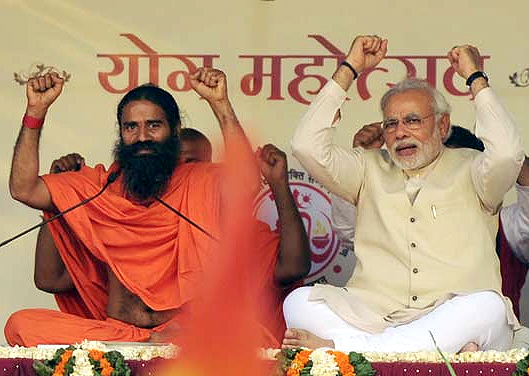India has its first ‘yoga czar,’ Shripad Yesso Naik. His official title is “Minister of Ayurveda, Yoga and Naturopathy, Unani, Siddha and Homoeopathy” (AYUSH) and his appointment is part of Narendra Modi’s reorganization of his cabinet toward a larger political goal: that of uniting Indian Hindus against perceived foreign influence.
Naik is commited to Modi’s goal to make yoga readily available to Indians across the nation and credits the controversial yoga guru Baba Ramdev for having made major advances in popularizing yoga in India. (Recently, Ramdev has made the outrageous claim that yoga can cure homosexuality—he also supports the Indian government’s ongoing criminalization of sex between consenting adults of the same sex—as well as the far-reaching claim that it could cure cancer.)
Modi’s recent efforts to reclaim yoga for India are just one part of a much larger public movement to define yoga by locating some monolithic “center” or essence, especially one that attributes a particular religious or national identity to yoga. The debate over what yoga is and to whom it belongs is longstanding.
For several years, for example, some members of the Indian Parliament have attempted to make yoga compulsory in public schools as a part of physical education, angering certain Indian Muslims who suggest that teaching yoga in schools is a part of a Hindu nationalist agenda and tantamount to religious indoctrination.
And, as I have written earlier here on RD, there is an international campaign that supports the idea that yoga is Hindu—but its purpose is to instill fear of the practice in Christians. Yoga alarmists have included Albert Mohler, Pat Robertson, and the Congregation for the Doctrine of the Faith of the Roman Catholic Church.
On the one hand, Christian opponents warn about the dangers of yoga for Christians, given the perceived incompatibility between yoga’s Indian origins and Hindu essence and Christian doctrine. They attempt to convince Christians that religious conflict is inevitable if they embrace yoga. Some American Christians add that yoga’s popularization contributes to the establishment of a “post-Christian” nation, something Americans should fear.
On the other hand, Hindu opponents of yoga’s popularization criticize yoga consumers for failing to recognize yoga’s so-called Hindu origins and, in turn, denounce yoga marketers’ for illegitimately coopting yoga and selling it as a consumer product.
+++
As Katherine Stewart reported here in 2013, some parents in Encinitas began a campaign to remove recently introduced yoga classes from public schools, arguing that yoga promotes Hinduism. The parents worked in conjunction with the National Center for Law & Policy (NCLP), an evangelical Christian civil liberties organization, which sued the school district. The NCLP suggested the Jois Foundation (a non-profit organization founded in memory of Krishna Pattabhi Jois and responsible for granting the EUSD a $533,000 grant to support the yoga classes) was a Hindu institution in secular guise.
In her expert witness brief, religious studies scholar Candy Gunther Brown supported the NCLP, arguing that the EUSD yoga curriculum promotes Hinduism even if they abandon Hindu language. Timothy Baird, the EUSD Superintendent, responded that the EUSD was promoting physical wellness, not religion. The court sided with the EUSD, allowing yoga to be taught in Encinitas public schools.
I will add only one more example of recent public attempts to negotiate yoga’s place in civil society based on essentializing visions of yoga.
In 2002, there was a transnational public outcry in response to Bikram Choudhury’s attempt to enforce copyrights over Bikram Yoga’s sequence of twenty-six postures. In part as an act of resistance to Choudhury and his organization, the Indian government-run Traditional Knowledge Digital Library (TKDL) created a database of 1,300 yoga postures believed to be documented in ancient Indian texts, therefore resisting corporate claims of ownership by suggesting they were misappropriations of “India’s traditional knowledge.”
Unlike the United States Copyright Office, which resisted corporate claims of ownership by offering a legal and essentializing definition of yoga as “exercise” aimed at improving “health,” the government of India currently offers up another essentializing definition of yoga as “a means of uniting the individual spirit with the universal spirit of God” and links yoga to a specific canonical text, the Yoga Sutras.
+++
The debates described above involve attempts to define yoga in ways that limit it to within certain bounded categories of identity, belief, or behavior, such as “exercise,” “religion,” “Indian,” or “Hindu.” But yoga identities have not been static or one-dimensional. Instead, they have been rich and dynamic as well as fragmented, fractured, and contested.
Unfortunately, Modi’s recent efforts are mired in inaccurate myths of yoga’s static essence and Indian origin. What we need more than these ill-conceived claims to ownership is an approach to yoga that accounts for its heterogeneity.
Critics like Modi especially hesitate to acknowledge the legitimacy of popularized transnational yoga systems because its products and services are specific to the context of a globalized world dominated by consumer culture. But rather than write off certain varieties of yoga as mere commodities, we need to recognize they share with other yoga systems the quality of being specific to a social context—and just because that social context is consumer culture does not mean that they do not have meaning.
Though there is no doubt that in our consumer culture many yoga insiders think of yoga as simply the best form of exercise and love yoga pants because they think they make their butts look good, but there are also consumers and marketers who are buying and selling yoga as a means to moral improvement, resolution of suffering—or even enlightenment.
Anyone interested in approaching yoga in a way that responsibly accounts for its heterogeneity and context-sensitivity and that avoids revisionist histories must resist the tendency to locate yoga’s origins or an essence around which all yoga practice revolves.
In other words, I do not accept Modi and others’ recent attempts to define yoga based on some assumed national or religious identity. Yoga, in its historic and lived reality, is an ongoing process. It includes a variety of historical as well as living, dynamic traditions—hence the divergences between many premodern Buddhist, Jain, and Hindu yoga advocates, whether philosopher-ascetics, ecstatic bhaktas or devotees, or sinister villains in pursuit of power, who embraced and prescribed yoga both within and beyond the borders of what is today the State of India—not to mention the living yoga giants, Baba Ramdev and Bikram Choudhury, or American yoga entrepreneurs like tantric-fitness advocate John Friend or the evangelical Christian “Holy Yoga” of Brooke Boon.
These yoga insiders have little in common with one another, yet according to each of them, they are doers of yoga. Any attempt to decide who counts as a legitimate yogi based on a particular national or religious identity (likely constructed long after the historical emergence of yoga itself) is both historically and socially misguided.





